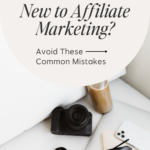
New to Affiliate Marketing? Avoid These Common Mistakes! (Pretty Links)
Table of Contents
ToggleSharing is caring!
Reading Time: 4 minutes
Joining an affiliate program is exciting, but if you see dismal clickthroughs or inconsistent traffic, you might feel disappointed and disheartened about your newest venture.
While affiliate marketing can provide a steady stream of passive income, it will take some time and a lot of effort to see positive results. Marketing and selling affiliate products aren't something you can set and forget, after all.
If you're not seeing the results you expected from your affiliate marketing campaign, it's time to give a long, hard look at your marketing strategies and see which areas need improvement. By continuously monitoring your marketing campaign and improving your strategy, your efforts won't fall flat, and you'll enjoy more commissions. Here are some affiliate marketing mistakes that you need to avoid at all cost:

5 Common Affiliate Marketing Mistakes to Avoid
You're too Pushy
When selling something, it's easy to come on too strong with the sales pitches because you want to earn as much as possible with every piece of content you create. That's normal because we all want to be well compensated for our hard work. But when you're focusing too much on selling and not so much on helping people, it will cause user friction, and you'll start putting a lot of customers off.
When your content is concentrated on selling alone, the quality decreases, leading to abysmal results. Worse, people will start looking elsewhere because the quality has gone down, and you're starting to sound insincere. So lesson learned: don't be pushy. Prioritise quality and provide helpful content, first and foremost.
The content is hard to read!
The readability of your content matters because many visitors have a low tolerance for hard-to-read content. The font style, font size, background colour, and website design should complement one another to present your content in the best manner possible.
Use a simple font style that's easy to scan and a font size no smaller than 16 pt. Opt for a clean, simple website design that's easy to navigate. In terms of the actual content, keep the sentences short and break the long text into a paragraph every 4 sentences. Finally, avoid using words that are hard to understand. If you have to look up the meaning of a word when writing, don't use it at all. The majority of readers prefer a 7th to 8th-grade readability level.
You are signing up for too many affiliate programs
The idea of earning money through multiple streams of income sounds tempting but avoid signing up for too many affiliate programs because it will affect the quality of your content and its impact on your readers. You don't want your website to look like a marketplace because you endorse too many products. If you're selling too many things, readers will start doubting your authority, affecting your brand image and sales.
Instead of signing up for too many affiliate programs, focus your energy on a product you genuinely believe in. Spend time learning about the product and how it can help people. Test it out yourself and start writing the content, then take it from there. Add another product to promote only when you've started seeing results from your marketing campaign. And even then, enable only the products that you genuinely believe in, goods that are helpful to your readers.
Forgetting about SEO
Search Engine Optimisation or SEO remains an effective marketing strategy to boost a brand's online presence. If you want to widen your reach and take your business in front of customers, do not skip SEO!
Optimising your content leads to higher search engine results, which enables more people to access your content. Because more people are seeing your content on the search pages, your clickthrough rate will skyrocket, and your SEO efforts will gradually translate to MORE sales.
Ruining your posts with unattractive affiliate links
Let's be real; affiliate links aren't exactly pretty to look at, and many times, the jumbled numbers and letters on an affiliate link clash with your website design. Unattractive URLs affect the readability of your content too. Shortening URLs work best for social media campaigns because many platforms tend to limit the characters you can use in a post.
PrettyLinks will trim down the unnecessary letters and numbers on an affiliate link, enabling you to create on-brand, customised, and memorable content that you can share on social media sites and beyond. You can use the free and paid version to customise the URLs. Getting the paid version allows you to track the performance of your affiliate links, which will improve future promotions.
As for link cloaking, this is a way to avoid using complicated-looking URLs and promote better security. You customise a link while redirecting to the original website page. This helps protect sensitive information by hiding your affiliate ID from malware. Link cloaking also boosts credibility, clickthrough rates, and conversions!
… And there you have it, the five most common mistakes that every affiliate marketer – old and new – should avoid at all cost! Are you guilty of committing any of these mistakes? Improve your marketing strategy so your hard work won’t go to waste.
Most Popular Posts:
Sharing is caring!
[…] content creation, sponsored content and affiliate marketing. The terms for sponsored content and affiliate marketing will vary between brands and influencers, but usually, the setup is cost-per-post. This means […]
[…] your source of income. There are numerous ways to do this, but none more lucrative and common than affiliate marketing, which can make you around $30,000 per year. However, there are some rules around using affiliate […]